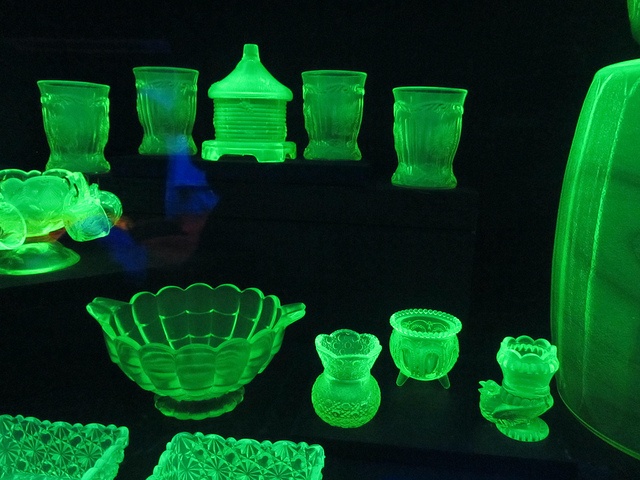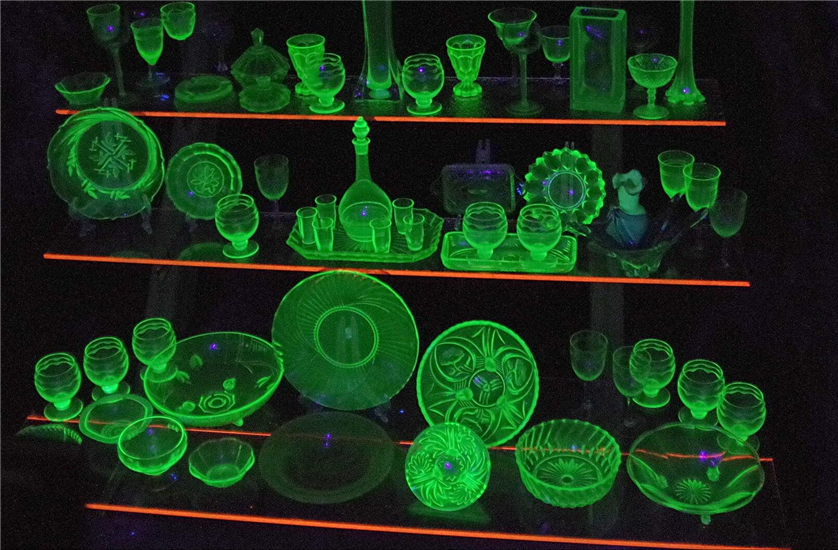Table of Contents
Uranium glass, also known as Vaseline glass or Depression glass, holds a unique place in the realm of collectibles and historical artifacts. Its distinct green or yellowish-green glow under ultraviolet light has captivated enthusiasts for decades. In this comprehensive article, we delve deep into the origins, properties, uses, and cultural significance of uranium glass, exploring its journey from scientific curiosity to cherished collector’s item.
Origins and History

Uranium glass traces its origins back to the early 19th century when experiments with uranium compounds began to reveal their fascinating fluorescent properties. In 1830, British physicist Sir William Herschel discovered the fluorescence of salts under sunlight. This discovery laid the groundwork for further experimentation, eventually leading to the production of uranium glass.
The first documented use of uranium glass dates back to the mid-19th century in Europe. Initially, it was primarily used for decorative items, such as beads and marbles. However, its popularity soared during the late 19th and early 20th centuries, particularly in the United States, where it became a prominent feature in household items and tableware.
Properties and Manufacturing Process

Uranium glass derives its distinctive color and fluorescence from the inclusion of uranium dioxide (UO2) in the glass mixture. Typically, uranium content ranges from trace amounts to around 2–25% by weight, although higher concentrations are possible for specialized applications.
The manufacturing process for glass is similar to that of conventional glass, with the addition of uranium compounds during the melting stage. Once cooled, the glass exhibits its characteristic green or yellowish-green hue, which can vary depending on factors such as concentration and oxidation state.
Uses and Applications
Throughout its history, glass has found diverse applications across various industries. In the early 20th century, it was commonly used for tableware, including drinking glasses, plates, bowls, and decorative items such as vases and candle holders. Its distinctive appearance made it a popular choice for elegant dining and entertaining.
Beyond decorative and household items, uranium glass has also been utilized in scientific instruments, particularly for its fluorescent properties. In laboratories, it was employed in the manufacture of Geiger counters, fluorescent lamps, and other devices requiring UV-sensitive materials.
Cultural Significance and Collectibility

Uranium glass holds a special allure for collectors and enthusiasts, who are drawn to its unique aesthetic appeal and historical significance. The vibrant green glow of uranium glass under ultraviolet light adds an element of mystery and fascination, making it highly sought after by collectors worldwide.
Collectors often prize uranium glass for its rarity, craftsmanship, and connection to specific historical periods. Certain manufacturers, such as Fenton Art Glass Company and Mosser Glass, are particularly renowned for their glass creations, which command premium prices among collectors.
Safety and Concerns
Despite its beauty and historical value, concerns have been raised regarding the safety of glass, primarily due to its radioactive properties. While glass does emit low levels of radiation, the risk to human health is considered minimal under normal conditions of use.
However, precautions should be taken when handling glass, especially vintage items that may have accumulated dust or residue over time. Avoid prolonged exposure, minimize contact with food or beverages, and wash hands thoroughly after handling uranium glass objects.
Conclusion
Uranium glass stands as a testament to the ingenuity of glassmakers and the enduring allure of fluorescent materials. From its humble beginnings as a scientific curiosity to its status as a cherished collector’s item, uranium glass has left an indelible mark on the worlds of art, design, and culture.
As we continue to explore the mysteries of glass and uncover new insights into its properties and uses, one thing remains certain: its luminous beauty will continue to captivate and inspire generations to come.
I hope you find this article comprehensive and engaging. If you need further information or modifications, please let me know!
For More Information Please Visit These Websites Mindmeister
Thank you for your sharing. I am worried that I lack creative ideas. It is your article that makes me full of hope. Thank you. But, I have a question, can you help me? https://www.binance.com/uk-UA/register?ref=W0BCQMF1
Thank you for your sharing. I am worried that I lack creative ideas. It is your article that makes me full of hope. Thank you. But, I have a question, can you help me?